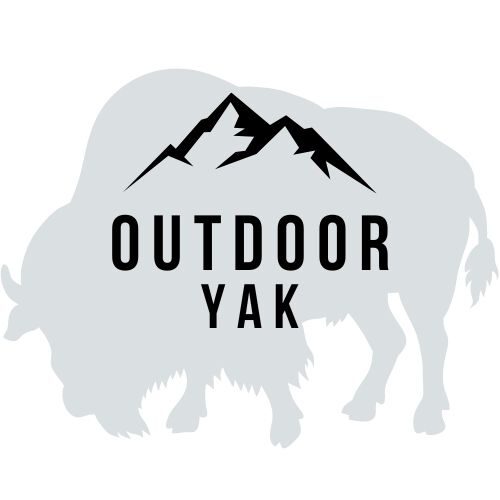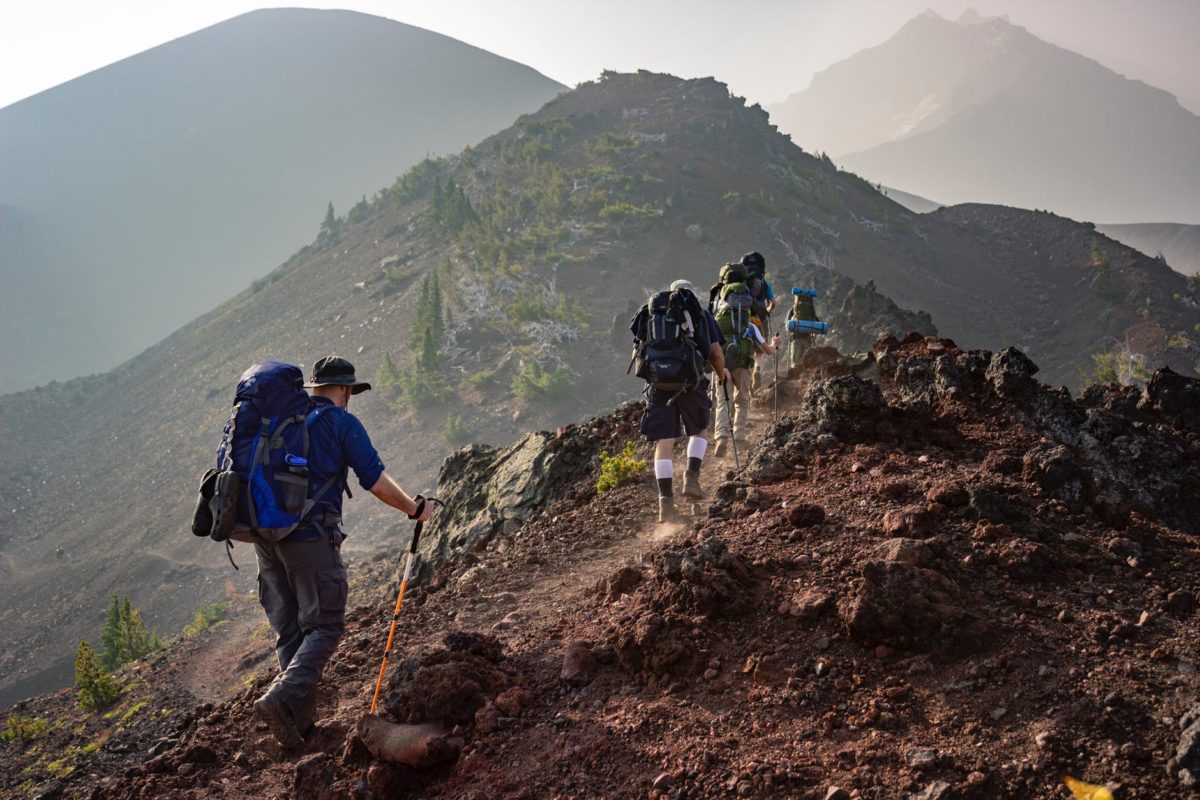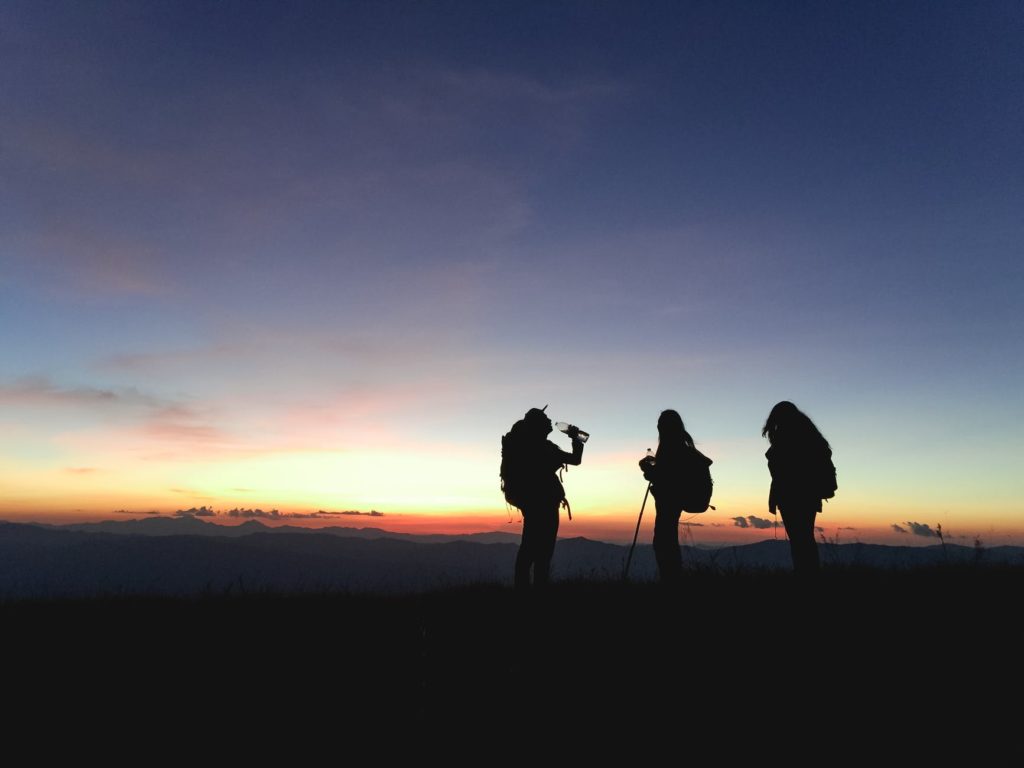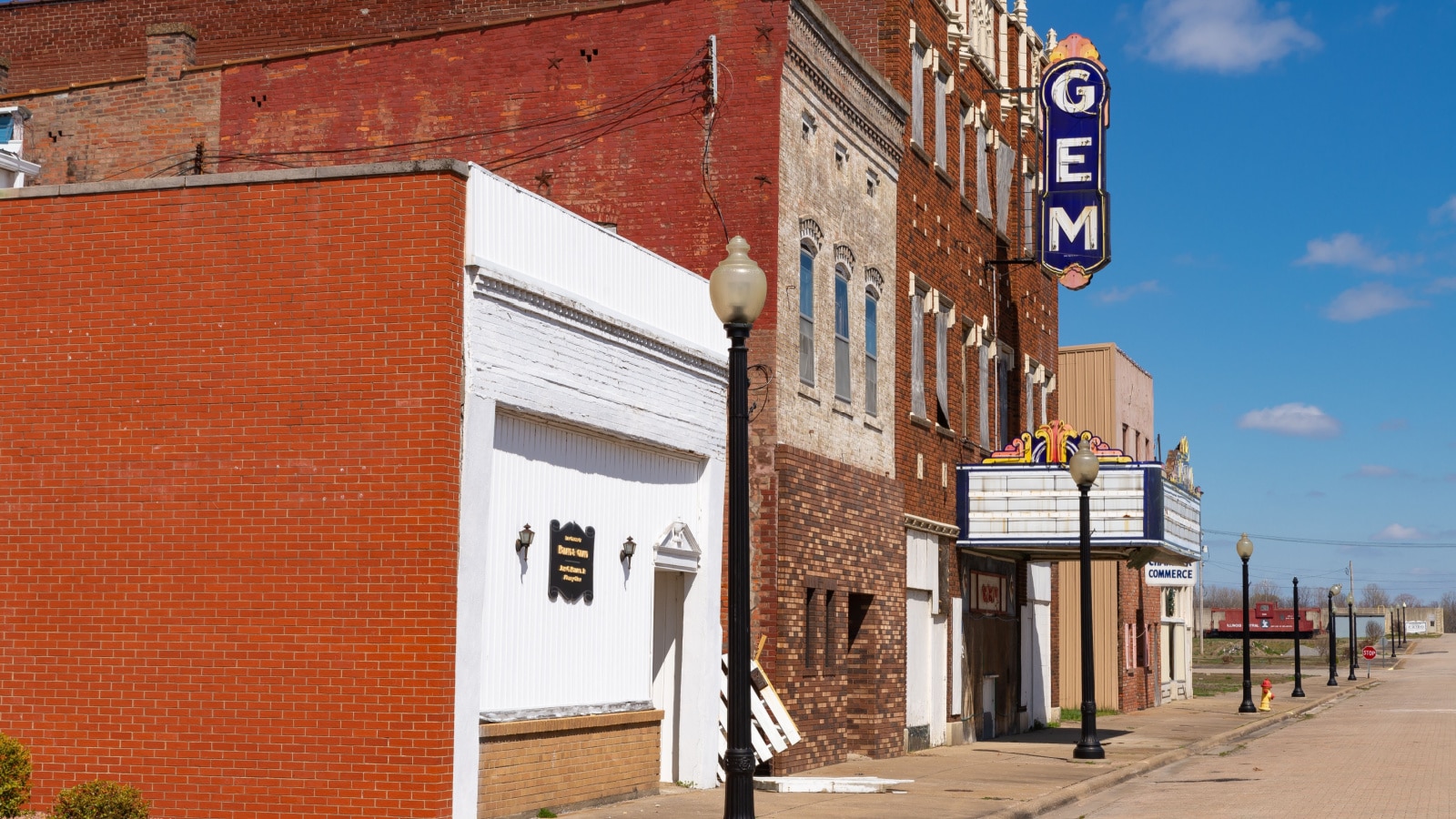Planning an upcoming hike and wondering if you’ll benefit from using hiking poles? In this guide, I’ll run over all the pros and cons of trekking poles to help you decide if you need them or not.
Reasons to use hiking poles
1. Poles protect your knees
Poles are not a magical cure for knees pain, but there is evidence that poles help you shift your weight in a way that reduces knee strain. Many hikers have found that they’re knees take less of pounding when the switch to using poles and really do benefit from the extra support and points of contact with the ground.
I went to poles several years ago after a minor knee injury descending the Little Merced River into Yosemite Valley. It was an easy decision: Poles save the knees.
Rick, SlackPacker
A great way to reduce knee pain is to focus on stepping on your fore and mid-foot instead of the heel. Studies have shown that this decreases the chance of lower limb injuries and reduces the load on your knees. You can do this without poles, but many hikers find that poles provide the extra support to make this forward loading stance more of a habit.
2. Poles give you more balance
Backpacks are heavy and all that extra load on your back can result in bad posture or decrease in stability when walking up or downhill. Hiking poles provide two more points of contact out in front of your body – which can act as counter-supports to more easily distribute your load.
I find that when I’m out trekking with a fully loaded backpack (rather than just a day pack) trekking poles help me to stay more stable, whilst also giving me better traction when walking on loose or slippery ground.
When you’re hiking through streams, up loose scree or down rocky paths – poles provide that extra bit of assistance to give you stability and balance. For the same reason that skiers use poles – hiking poles provide an extra point of contact with the ground, stabilizing your footing and helping your sense the terrain ahead.
3. Poles set a steady pace
There’s something really special when you break through the first hour of a hike and get into a steady pace that carries you through till dusk. Putting each pole forward with that 1-2 motion really helps to set a pace and keep a constant speed.
The forward stride and pattern of reaching out to lay down a pole and then following with your feet is a great way to get in the zone.
4. Poles help with posture
I find that when I use poles my posture when hiking is naturally more upright. Instead of a bent back and leaning excessively into the mountain, with poles I can maintain more upright posture and lets the poles lean into the mountain with each stride.
Over the long term, your hiking posture can have a huge impact on preventing fatigue in your back muscles, so be aware of how your walking throughout the day and adjusting to the terrain is really important. Again, you can definitely hike with great posture without using poles, but I find that poles help enormously.
5. Poles give you a boost uphill
When hiking uphill, poles provide greater leverage and a boost to your walking speed. They make it easier to ascent at speed and allow you to use your arms and shoulders alongside your leg muscles.
6. Poles reduce injury risk
Trekking poles allow you to distribute some of your weight from your legs to your arms and shoulders – which reduced lower body fatigue.
One study has shown that trekking poles reduce joint forces on the knee and the hip joint while another study shows that those hikers who use poles are less likely to suffer ankle fractures.
7. Poles allow you to hike further
The average hiking speed is between 3-5kph – many hikers find that by using poles they can cover more distance in the same amount of time.
That’s because trekking poles help you set a faster rhythm and use more of your muscles (rather than over-extending just your leg muscles which increase fatigue faster).
8. Poles can be used to whack away shrubs
Trails are not always clear and shrubs are constantly growing. With poles, you can easily whack away overhanging leaves or small branches that are in your way. Rather than ripping into your clothing or scratching your bare calves – you can bat away the shrubs as your trailblaze your way through.
Of course, they’re not machetes and there is a limit to the force they can sustain before they’ll buckle, but for leaves and thin branches poles are resilient and incredibly useful.
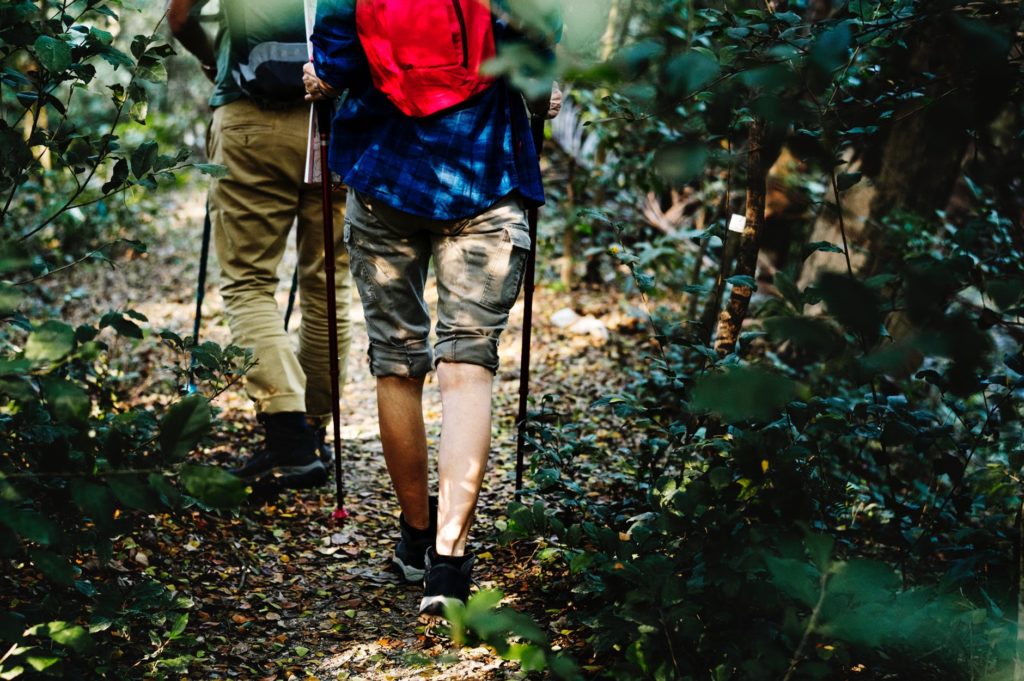
9. Poles make hiking safer in the dark
When the sun sets and you’re hitting the trail at dusk or in through the night, poles help you feel the path ahead. Of course, you can’t hike with poles alone and you should always be prepared with a powerful hiking headlamp, but poles allow you to feel with your hands and maintaining greater traction in low-light conditions.
10. Use poles as tent poles
For some ultralight backpackers using minimalist tents – trekking poles can be used as the tent poles. If you’re looking to save weigh on your next camping trip and camp with the bare essentials then having dual-purpose equipment is a smart idea.
Bonus #1: Scare off bears
If you want to scare away wild animals, bashing your poles together to make a clinky metal sound is a great way to do so.
You can hit your poles together every mile or so to scare away animals in the area – the unnatural sound will frighten some animals away and make it less likely that you’ll encounter them on your trek. (Of course, avoid doing this – if you’re not in a high-risk area and you want to see more animals).
You can also use your poles to make a sound if you fall down, get stuck or signaling for help in an emergency. Poles can make a moderately loud sound with minimal effort.
Bonus #2: Selfie stick
A little known tip is that you can transform your poles into selfie sticks. If you want a selfie stick to take some photos of you and your hikes while out on the trails – you need what’s called a selfie tip attachment which you pick up on Amazon.
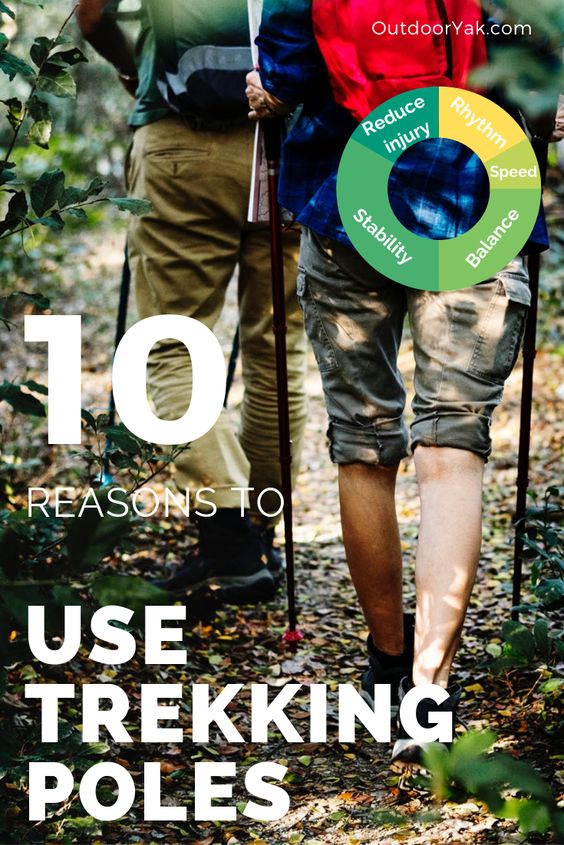
Arguments against hiking poles
While I’m firmly in the pro camp for multi-day trecks, for shorter hikes or day hikes I usually walk without them.
There are a few reasons that people choose not to use poles and here are some of them.
1. Extra weight to carry
Poles are light, but they’re still an extra item to carry. If you’re a minimalist packer and like to travel as light as possible, then poles may be an extra burden that you might not want to deal with. (choose extendable and collapsible poles where possible).
2. No free hands
With poles your hands are constantly occupied (not necessarily a bad thing) which some hikers don’t like. It can make reaching for your water bottler and taking off your backpack a bit more trouble. Another reason you might want your hands free is if you’re taking lots of photos (although you can turn your pole into a selfie stick).
3. Poles increase energy output.
There is some debate on this, but there is some agreement that poles do increase your energy expenditure – because they allow you to use more muscles to drive yourself forward.
With poles, you’ll benefit from a faster pace and more stability, but you’re likely to use 1-5% more energy.
Best Trekking Poles for 2019/2020
- Alpine Summit Trekking Poles – Check Price on Amazon
- Black Diamond Alpine Carbon – Check Price on Amazon
- Cascade Mountain Tech Carbon (budget) – Check Price on Amazon
Final thoughts
Trekking poles are awesome, but you don’t need them to be a hiker!
If you want more stability, traction and rhythm then you’re going to really enjoy your first trip into the outback with poles.
You don’t need the most expensive poles out there, but it’s worth getting a pair that are made from strong aluminum (or carbon), have comfortable grips and are extendable.
I hope you enjoyed this guide – please do take a look at our gear reviews and other outdoor tips.
Can I use ski poles as trekking poles?
Yes you can. Their length might not be optimum for your height and they won’t be adjustable like trekking poles – but they will do a decent enough job.
The great thing about adjustable poles is that you can shorten or lengthen them to match the steepness of the slope. This isn’t something you need to do every time the angle changes – but they give you the option of doing so.
On trails that are cut into the hill, you can shorten the poles to hit the trail at the right angle or lengthen in other parts of the trail for more comfort.
